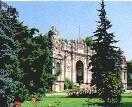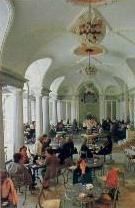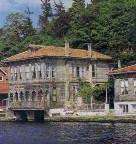Bosphorus

|
A stay in Istanbul is not complete without the traditional and unforgettable boat excursion up the Bosphorus, the winding strait that separates Europe and Asia. Its shores offer a delightful mixture of past and present, grand splendor and simple beauty. Modern hotels stand next to yali (shore-front wooden villas), marble palaces abut rustic stone fortresses, and elegant compounds neighbor small fishing villages. The best way to see the Bosphorus is to board one of the passenger boats that regularly zigzag along the shores. You embark in Eminonu and stop alternately on the Asian and European sides of the strait. The round trip excursion, at a very reasonable cost, takes about six hours. If you wish a private voyage, you can contact one of the agencies which specialize in organizing day or night mini-cruises.
|



|
During the journey you pass in front of the magnificent Dolmabahce Palace; farther along rise the green parks and imperial pavilions of Yildiz Palace. On the edge of this park, on the coast, stands the Ciragan Palace now restored as a grand hotel. Refurbished in 1874 by Sultan Abdulaziz, it stretches for 300 meters along the Bosphorus shore, its ornate marble facades reflecting the swiftly moving water. At Ortakoy,the next stop, artists gather every Sunday to exhibit their works in a streetside gallery. The variety of people create a lively scene; sample a delicious bite from one of the street vendors. Overshadowing the traditional architecture of the village, the Bosphorus Bridge, one of the world's largest suspension bridges links Europe and Asia.
The beautiful Beylerbeyi Palace lies just past the bridge on the Asian side. Behind the palace rises Camlica Hill,the highest point of Istanbul. You can drive here to admire the magnificent panorama of Istanbul as well as the beautiful landscaped gardens. On the opposite shore, the wooden Ottoman villas of Arnavudkoy contrast with the luxurious modern apartments of neighboring Bebek. A few kilometers farther out, facing each other across the straits like sentries guarding the city, stand the fortresses of Rumeli Hisari and Anadolu Hisari. The Goksu Palace, sometimes known as Kucuksu Palace graces the Asian shore next to the Anadolu Hisari. The recently completed second link between the two continents, the Fatih Sultan Mehmet Bridge straddles the waterway just past the two fortresses.
From Duatepe Hill, on the European side, you can admire the magnificent panorama of the bridge and the Bosphorus. Below Duatepe, the beautiful Emirgan Park with its delightful pavilions bursts with color when the tulips bloom in the spring. Opposite on the Asian shore is Kanlica, a fishing village now a favored suburb for wealthy Istanbulites. Crowds gather in the restaurants and cafes along its shores to sample its famous yoghurt. Shortly after Kanlica,at Cubuklu,the Hidiv Palace emerges from a tranquil grove. Now a hotel,the palace buzzes with the activity of concerts and conferences. Past the Hidiv Palace, the Beykoz Korusu (Abraham Pasa) Korusu Woods are a popular retreat. Complete with cafes and restaurants you can enjoy the delighiful views and clear fresh air. On the European side, at Tarabya Bay, yachts seem to dance at their moorings. The coast road bustles with taverns and fish restaurants from Tarabya until the charming villages ot Buyukdere and Sariyer. A little further on the narrow strait widens and disappears into the Black Sea.
|
|
The Golden Horn, a horn-shaped estuary, divides European Istanbul. One of the best natural harbors in the world, the Byzantine and Ottoman navies and commercial shipping interests were centered here. Today, lovely parks and promenades line the shores. In the setting sun, the water shines a golden color. At Fener, a neighborhood midway up the Golden Horn, whole streets of old wooden houses and churches date from Byzantine times. The Orthodox Patriarchy resides here. Eyup,a little further up,reflects the Ottoman style of vernacular architecture. Cemeteries sprinkled with dark cypress trees cover the hillsides. It is always busy here with pilgrims coming to the tomb of Eyup in the hope that their prayers will be granted. The Pierre Loti Cafe atop the hill overlooking the shrine is a wonderful place to enjoy the tranquility of the view.
|

|

|
 
This site prepared by Tayfun Kalyoncu on 28.02.1997 and last updated on 01.05.1999.
For any comments and suggestion please send an e-mail using the form at page mailform.html
|





